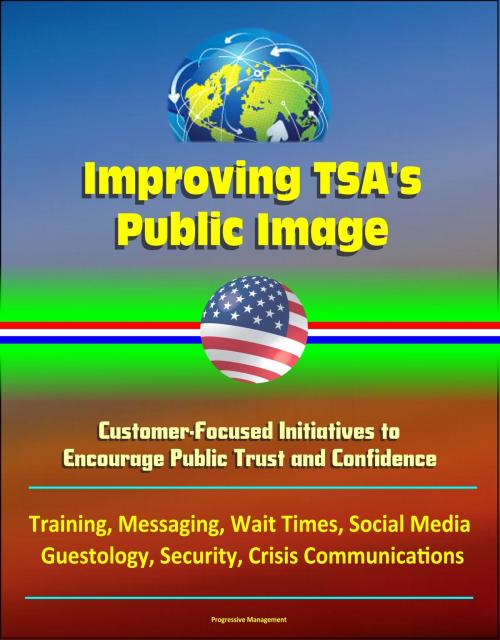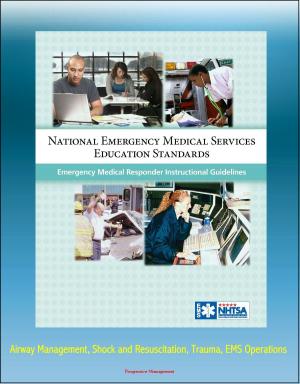Improving TSA's Public Image: Customer-Focused Initiatives to Encourage Public Trust and Confidence - Training, Messaging, Wait Times, Social Media, Guestology, Security, Crisis Communications
Nonfiction, Reference & Language, Transportation, Aviation, Commercial| Author: | Progressive Management | ISBN: | 9781311585509 |
| Publisher: | Progressive Management | Publication: | November 18, 2015 |
| Imprint: | Smashwords Edition | Language: | English |
| Author: | Progressive Management |
| ISBN: | 9781311585509 |
| Publisher: | Progressive Management |
| Publication: | November 18, 2015 |
| Imprint: | Smashwords Edition |
| Language: | English |
Professionally converted for accurate flowing-text e-book format reproduction, this report explores TSA's public-image challenges and identifies customer-focused solutions. The Transportation Security Administration (TSA) can improve its public image by looking at the problem from the customer's perspective.
Research methods include a case study analysis on Southwest Airlines and Disney and an extensive literature review to identify smart practices that are applicable to TSA. TSA needs to implement customer-focused strategies that are more effective in dealing with the agency's public-image challenges. A TSA strategy designed to build a more positive work environment, improve messaging and information sharing, increase the focus on customer service, and utilize customer feedback to improve operations, will begin to improve public opinion. There is a disconnect between TSA's intentions and the public's perceptions, and it is time to seek new opportunities to improve the public's trust and confidence. It is easy for some to be critical about an agency that screens over 1.7 million passengers each day and often has to get into the passenger's personal space in order to do so. TSA's first priority is and should be security, but public opinion is also important. Increasing public confidence in TSA may also result in more acceptance and cooperation with security processes, resulting in increased security effectiveness.
I. INTRODUCTION * A. RESEARCH QUESTION * B. PROBLEM STATEMENT * 1. Background and Significance * 2. Assumptions and Limitations of Research * 3. Bias and Theoretical Sensitivity * 4. Consumer of this Information * 5. Hypothesis * C. RESEARCH METHODOLOGY * D. LITERATURE REVIEW * 1. Understanding the Issues * 2. Government Focus on Customer Service * 3. Strategic Communications * 4. Case Study Literature * 5. Conclusion * E. ORGANIZATION OF THESIS * II. TSA'S PUBLIC-IMAGE CHALLENGES * A. TOP CHALLENGES * 1. Lack of Information Provided to the Public About Security Threats or Security Procedures. * a. Challenges in Messaging * b. Aviation Security Messages Provided Elsewhere * c. Engaged Public Can Participate in Security * 2. Unpopular Screening Procedures * a. Risk-Based Security * b. Public Opinion Polls * 3. Customer Service Perceptions * a. Passengers Should Expect Good Customer Service * b. Passengers Have an Impact on Their Own Experience * c. Professionalism During Difficult Situations * 4. Negative Media, Lack of Political Support, and Aviation Stakeholders Influence Public Opinion * a. TSA Needs to Take Control of the Debate * b. Public Relies on Distorted or Inaccurate Media Coverage * c. Negative Media Coverage is Common * d. Employee Scandals Do Not Help * e. Government Leaders Impact Public Opinion * f. Aviation Stakeholders Also Impact Public Opinion * B. IMPACT OF PUBLIC-IMAGE CHALLENGES * 1. Loss of Public Trust and Confidence * a. Negative Publicity * b. Information Needs to be Put Out In Advance * c. Proactive Crisis Communication * d. TSA Needs to Deliver the Message * 2. Mission Impact * a. Mission Effectiveness * b. Mission Efficiency * 3. Employee Morale * a. Value of Positive Reputations * b. Passenger Overreactions * c. Everyone is an Expert * C. IT IS TIME TO TRY A NEW APPROACH BY SEEKING SMART PRACTICES FROM OUTSIDE OF GOVERNMENT * III. SOUTHWEST AIRLINES CASE STUDY * A. OVERVIEW * 1. Company Profile * 2. Focus on Employees * 3. Similarities * 4. Differences * 5. Case Study Goal * B. CASE STUDY OF SOUTHWEST AIRLINES SMART PRACTICES * 1. What Smart Practices Have Been Used to Promote a Positive Public Image? * a. Build a Positive Culture * b. Positive Messaging * c. Promote the Positive Culture in Corporate Language * d. Ensure Employees are Happy * e. Employee Recognition * 2. What Effective Strategies Have Been Used to Provide Good Customer Service? * a. Leadership Emphasis on Customer Service
Professionally converted for accurate flowing-text e-book format reproduction, this report explores TSA's public-image challenges and identifies customer-focused solutions. The Transportation Security Administration (TSA) can improve its public image by looking at the problem from the customer's perspective.
Research methods include a case study analysis on Southwest Airlines and Disney and an extensive literature review to identify smart practices that are applicable to TSA. TSA needs to implement customer-focused strategies that are more effective in dealing with the agency's public-image challenges. A TSA strategy designed to build a more positive work environment, improve messaging and information sharing, increase the focus on customer service, and utilize customer feedback to improve operations, will begin to improve public opinion. There is a disconnect between TSA's intentions and the public's perceptions, and it is time to seek new opportunities to improve the public's trust and confidence. It is easy for some to be critical about an agency that screens over 1.7 million passengers each day and often has to get into the passenger's personal space in order to do so. TSA's first priority is and should be security, but public opinion is also important. Increasing public confidence in TSA may also result in more acceptance and cooperation with security processes, resulting in increased security effectiveness.
I. INTRODUCTION * A. RESEARCH QUESTION * B. PROBLEM STATEMENT * 1. Background and Significance * 2. Assumptions and Limitations of Research * 3. Bias and Theoretical Sensitivity * 4. Consumer of this Information * 5. Hypothesis * C. RESEARCH METHODOLOGY * D. LITERATURE REVIEW * 1. Understanding the Issues * 2. Government Focus on Customer Service * 3. Strategic Communications * 4. Case Study Literature * 5. Conclusion * E. ORGANIZATION OF THESIS * II. TSA'S PUBLIC-IMAGE CHALLENGES * A. TOP CHALLENGES * 1. Lack of Information Provided to the Public About Security Threats or Security Procedures. * a. Challenges in Messaging * b. Aviation Security Messages Provided Elsewhere * c. Engaged Public Can Participate in Security * 2. Unpopular Screening Procedures * a. Risk-Based Security * b. Public Opinion Polls * 3. Customer Service Perceptions * a. Passengers Should Expect Good Customer Service * b. Passengers Have an Impact on Their Own Experience * c. Professionalism During Difficult Situations * 4. Negative Media, Lack of Political Support, and Aviation Stakeholders Influence Public Opinion * a. TSA Needs to Take Control of the Debate * b. Public Relies on Distorted or Inaccurate Media Coverage * c. Negative Media Coverage is Common * d. Employee Scandals Do Not Help * e. Government Leaders Impact Public Opinion * f. Aviation Stakeholders Also Impact Public Opinion * B. IMPACT OF PUBLIC-IMAGE CHALLENGES * 1. Loss of Public Trust and Confidence * a. Negative Publicity * b. Information Needs to be Put Out In Advance * c. Proactive Crisis Communication * d. TSA Needs to Deliver the Message * 2. Mission Impact * a. Mission Effectiveness * b. Mission Efficiency * 3. Employee Morale * a. Value of Positive Reputations * b. Passenger Overreactions * c. Everyone is an Expert * C. IT IS TIME TO TRY A NEW APPROACH BY SEEKING SMART PRACTICES FROM OUTSIDE OF GOVERNMENT * III. SOUTHWEST AIRLINES CASE STUDY * A. OVERVIEW * 1. Company Profile * 2. Focus on Employees * 3. Similarities * 4. Differences * 5. Case Study Goal * B. CASE STUDY OF SOUTHWEST AIRLINES SMART PRACTICES * 1. What Smart Practices Have Been Used to Promote a Positive Public Image? * a. Build a Positive Culture * b. Positive Messaging * c. Promote the Positive Culture in Corporate Language * d. Ensure Employees are Happy * e. Employee Recognition * 2. What Effective Strategies Have Been Used to Provide Good Customer Service? * a. Leadership Emphasis on Customer Service















